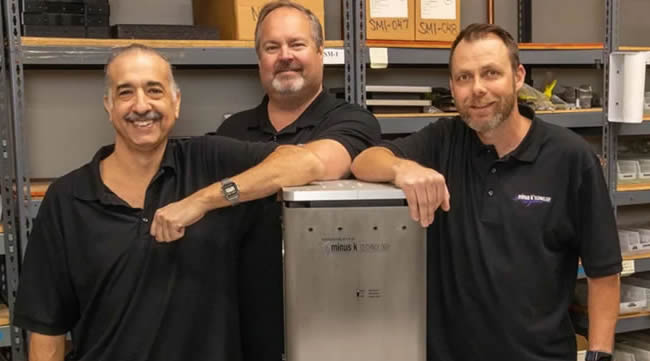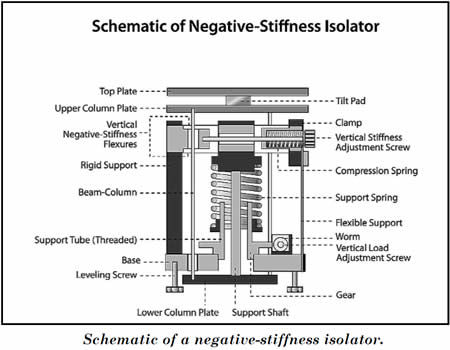
U.S. Tech - June 2024
Manufacturing Services
Negative-Stiffness Vibration Isolation, Enables Research into Sub-Micron Technology
By Jim McMahon

Minus K Technology principals (L to R) Steve Varma, Erik Runge and Jason Blain.
The need for nano-precision has become increasingly important in many fields of research and manufacturing, such as microelectronics fabrication, laser/optical system applications, life sciences, materials, aerospace and biological research.
This has brought with it the need to implement vibration isolation technology for stabilizing academia’s and industry’s most critical instrumentation to facilitate operation under extremely precise requirements operating at atomic-scale resolutions.
Eliminating Vibration
The need to provide adequate vibration isolation presents an increasingly important and complicated challenge, particularly at very low frequencies. Vibration influencing high-resolution sub-micron instrumentation can be caused by a multitude of factors. Within the building itself, the heating and ventilation system, fans, pumps and elevators are just some of the mechanical devices that create vibration.
How far away sensitive instrumentation is from these vibration sources, and where in the structure the equipment is located, will determine how strongly the equipment will be influenced. Internal and external influences cause low-frequency vibration in the 0.5 Hz to 50 Hz range, which is transmitted through the structure and into sensitive parts of instrumentation, compromising resolution, image quality, and the integrity of data.
Many vibration isolators, particularly at frequencies below 10 Hz, deliver limited isolation vertically and even less isolation horizontally. In fact, such isolators create vibration isolation problems in the region of their resonant frequency. All isolators will amplify at their resonant frequency then start isolating above this frequency.
As sub-micron research continues to advance at an accelerated rate, the need to protect sensitive instrumentation with better vibration isolation is critical.
Negative-Stiffness
There is a more advanced vibration isolation technology in use when it comes to protecting sensitive submicron instrumentation to low- Hertz vibrations. Introduced in the mid-1990s by Minus K Technology, Negative-Stiffness vibration isolation has been widely accepted for vibration-critical applications, largely because of its ability to effectively isolate lower frequencies, both vertically and horizontally.
Used in a broad spectrum of applications including microscopy, nanotechnology, biological sciences, semiconductors, materials research, zero-g simulation of spacecraft, and high-end audio, Minus K’s Negative-Stiffness isolators are supplied to leading manufacturers of scanning probe microscopes, micro-hardness testers and other vibration-sensitive instruments and equipment.
Negative-Stiffness vibration isolators are unique in that they operate purely in a passive mechanical mode. They do not require electricity or compressed air. There are no motors, pumps or chambers, and no maintenance because there is nothing to wear out.
“Vertical-motion isolation is provided by a stiff spring that supports a weight load, combined with a Negative-Stiffness mechanism,” says Erik Runge, vice president of engineering at Minus K. “The net vertical stiffness is made very low without affecting the static load supporting capability of the spring. Beam-columns connected in series with the vertical-motion isolator provide horizontal-motion isolation.
A beam-column behaves as a spring combined with a negative-stiffness mechanism. The result is a compact passive isolator capable of very low vertical and horizontal natural frequencies and high internal structural frequencies.”
Negative-Stiffness isolators achieve a high level of isolation in multiple directions, with the flexibility of custom-tailoring resonant frequencies to 0.5 Hz vertically and horizontally (with some versions at 1.5 Hz horizontally)*. When adjusted to 0.5 Hz, the isolators achieve approximately 93 percent isolation efficiency at 2 Hz; 99 percent at 5 Hz; and 99.7 percent at 10 Hz.
 Gravitational Waves
Gravitational Waves
Albert Einstein predicted the existence of gravitational waves in 1916, but only in the last 10 years has technology become powerful enough to permit detecting these waves and harnessing them for science. The GEO600 Ground-Based Interferometric Gravitational Wave Detector located at the Max Planck Institute for Gravitational Physics (also known as the Albert Einstein Institute) in Hannover, Germany, has played a pivotal role in the development and testing of new technologies for the detection of tiny spacetime ripples of gravitational waves.
Most notably on September 14, 2015, when GEO600 technology was employed in the Laser Interferometer Gravitational-Wave Observatory (LIGO) in Germany to make the first detection of gravitational waves from a binary black hole merger, confirming Einstein’s vision of gravitational waves and allowing a fascinating and unique view into the dark side of the cosmos.
“With laser interferometry we can retrieve information from spaces in the universe that is otherwise not accessible, and we can look back in time much further,” says Dr. Harald Lück, research group leader for the laser interferometry and gravitational wave astronomy division of the Albert Einstein Institute.
The central elements in all gravitational wave detectors are mirrors used to direct the laser beams. A significant challenge in gravitational wave interferometry is to get rid of disturbances like air pressure and temperature fluctuations, as well as seismic vibrations of all sorts that would conceal a signal.
“The GEO600 mirrors are supported by Negative-Stiffness vibration isolators which have made this discovery possible, and provided pivotal support for GEO600’s continuing research into the nature of gravitational waves,” adds Dr. Lück.
Technological Evolution
We are on the forefront of a technological evolution with sub-micron research in the fields of microelectronics, laser/optical systems, life sciences, materials, aerospace and biological research. Underpinning this research is the necessity for extremely low-Hertz vibration isolation of our most critical instrumentation to facilitate its operation at atomic-scale resolution. This demands a unique capability provided by Negative-Stiffness vibration isolation.
Contact: Minus K Technology, Inc., 460 Hindry Avenue, Unit C, Inglewood, CA 90301
310-348-9656. E-mail: request@minusk.com. Web: www.minusk.com
|